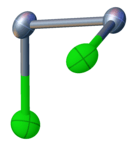Selenium monochloride
Selenium monochloride is an inorganic compound with the formula Se2Cl2. Although it is called selenium monochloride, a more descriptive name might be diselenium dichloride. It is a reddish-brown, oily liquid that hydrolyses slowly. It exists in chemical equilibrium with SeCl2, SeCl4, chlorine, and elemental selenium.[1] Selenium monochloride is mainly used as a reagent for the synthesis of Se-containing compounds.
 | |
| Names | |
|---|---|
| IUPAC name
Selenium monochloride | |
| Other names
Dichlorodiselenide, Diselenium dichloride, Selenium chloride, 1,2-dichlorodiselane | |
| Identifiers | |
3D model (JSmol) |
|
| ChemSpider | |
| ECHA InfoCard | 100.030.022 |
PubChem CID |
|
| UNII | |
CompTox Dashboard (EPA) |
|
| |
| |
| Properties | |
| Se2Cl2 | |
| Molar mass | 228.83 g/mol |
| Appearance | Reddish-brown oily liquid |
| Density | 2.7741 g/cm3 |
| Melting point | −85 °C (−121 °F; 188 K) |
| Boiling point | 127 °C (261 °F; 400 K) at 0.997 atm |
| insoluble | |
| Solubility in other solvents | Soluble in chloroform, carbon disulfide, and acetonitrile |
| −94.8·10−6 cm3/mol | |
| Hazards | |
| R-phrases (outdated) | R23/24/25-R34 |
| S-phrases (outdated) | S22-S26-S36/37/39-S45 |
Except where otherwise noted, data are given for materials in their standard state (at 25 °C [77 °F], 100 kPa). | |
| Infobox references | |
Structure and properties
Selenium monochloride has the connectivity Cl-Se-Se-Cl. With a nonplanar structure, it has C2 molecular symmetry, similar to hydrogen peroxide and sulfur monochloride. The Se-Se bond length is 2.23 Å, and the Se-Cl bond lengths are 2.20 Å. The dihedral angle is 87°.[2]
Preparation
Selenium monochloride was originally produced by the chlorination of selenium.[3] An improved method involves the reaction of a mixture of selenium, selenium dioxide, and hydrochloric acid:[4]
- 3 Se + SeO2 + 4 HCl → 2 Se2Cl2 + H2O
A dense layer of selenium monochloride settles from the reaction mixture, which can be purified by dissolving it in fuming sulfuric acid and reprecipitating it with hydrochloric acid. A second method for the synthesis involves the reaction of selenium with oleum and hydrochloric acid:[4]
- 2 Se + 2 SO3 + 3 HCl → Se2Cl2 + H2SO3 + SO2(OH)Cl
The crude selenium monochloride product is collected via distillation.
In acetonitrile solutions, it exists in equilibrium with SeCl2 and SeCl4.[5] Selenium dichloride degrades to the monochloride after a few minutes at room temperature:[6]
- 3 SeCl2 → Se2Cl2 + SeCl4
Reactions
Selenium monochloride is an electrophilic selenizing agent, and thus it reacts with simple alkenes to give bis(β-chloroalkyl)selenide and bis(chloroalkyl)selenium dichloride. It converts hydrazones of hindered ketones into the corresponding selenoketones, the structural analogs of ketones whereby the oxygen atom is replaced with a selenium atom.[7] Finally, the compound has been used to introduce bridging selenium ligands between the metal atoms of some iron and chromium carbonyl complexes.[7]
References
- Greenwood, Norman N.; Earnshaw, Alan (1997). Chemistry of the Elements (2nd ed.). Butterworth-Heinemann. ISBN 978-0-08-037941-8.
- Kniep, Rüdiger; Körte, Lutz; Mootz, Dietrich (1 January 1983). "Kristallstrukturen von Verbindungen A2X2 (A = S, Se; X = Cl, Br)". Zeitschrift für Naturforschung B. 38 (1): 1–6. doi:10.1515/znb-1983-0102.
- Lenher, Victor; Kao, C. H. (1925). "The Preparation of Selenium Monochloride and Monobromide". Journal of the American Chemical Society. 47 (3): 772–774. doi:10.1021/ja01680a025.
- Fehér, F. "Diselenium Dichloride". In Handbook of Preparative Inorganic Chemistry; Brauer, G., Ed.; Academic Press: New York, 1963; Vol. 1; p 422-433.
- Lamoureux, Marc; Milne, John (1990). "Selenium chloride and bromide equilibria in aprotic solvents; a 77Se NMR study". Polyhedron. 9 (4): 589–595. doi:10.1016/S0277-5387(00)86238-5.
- Maaninen, Arto; Chivers, Tristram; Parvez, Masood; Pietikäinen, Jarkko; Laitinen, Risto S. (1999). "Syntheses of THF Solutions of SeX2(X = Cl, Br) and a New Route to Selenium Sulfides SenS8-n(n = 1−5): X-ray Crystal Structures of SeCl2(tht)2 and SeCl2·tmtu". Inorganic Chemistry. 38 (18): 4093–4097. doi:10.1021/ic981430h.
- Back, Thomas G.; Moussa, Ziad (2003). "Diselenium Dichloride". Encyclopedia of Reagents for Organic Synthesis. doi:10.1002/047084289X.rn00201. ISBN 0471936235.CS1 maint: uses authors parameter (link)